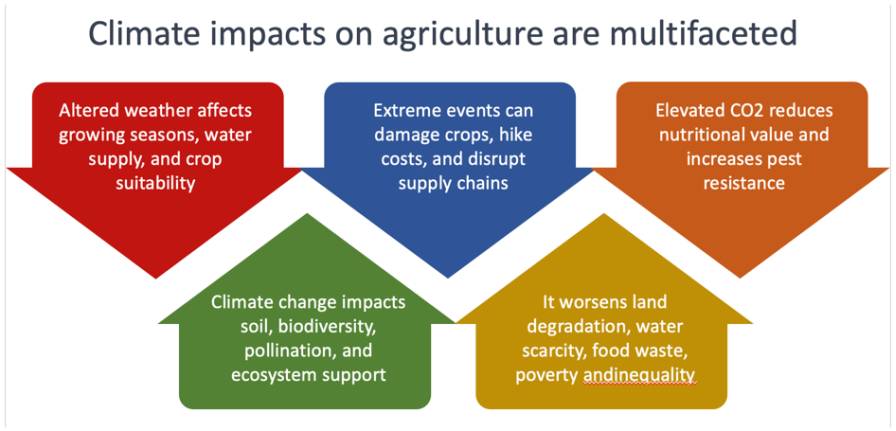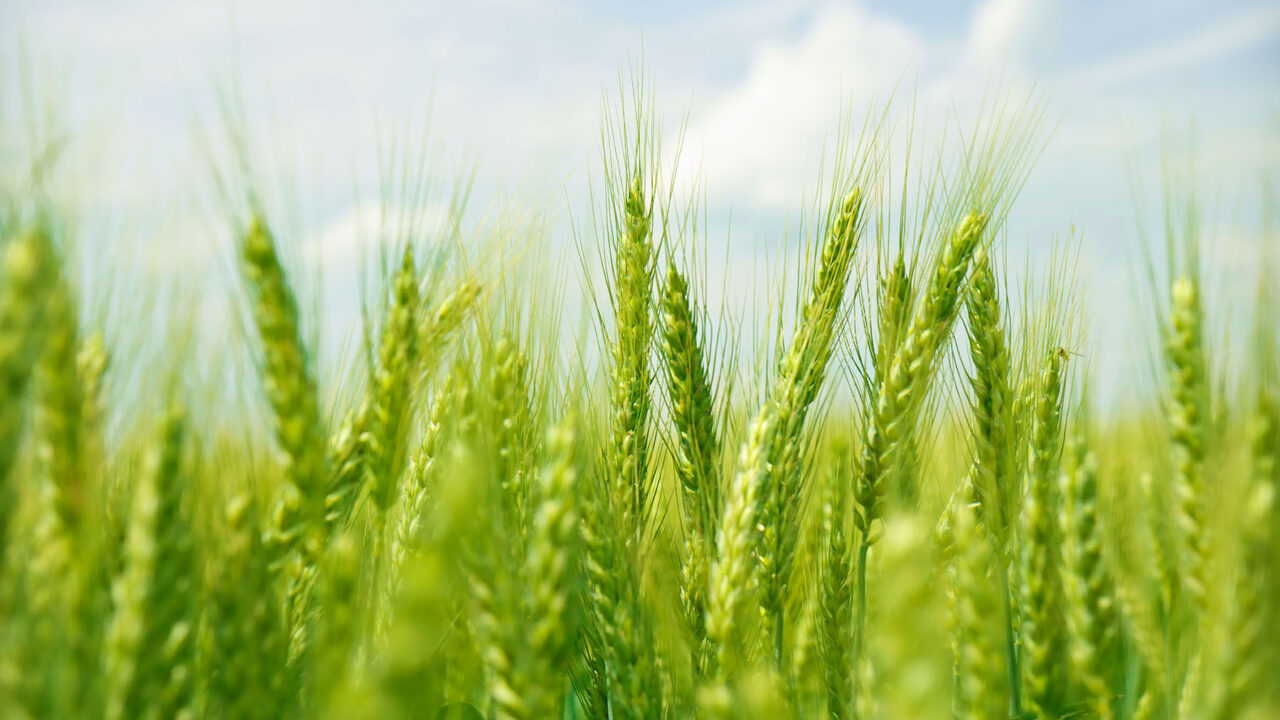The Future of Agriculture Is Climate-Smart Agriculture
Climate change is not a distant threat; it’s a stark reality. Extreme weather events, erratic rainfall, prolonged droughts, and destructive storms are all part of the new normal.
Agriculture, the bedrock of our society, is under siege, with farmers facing unpredictable growing conditions threatening their livelihoods. A Cornell-led study estimates that global farming productivity is 21% lower than it could have been without climate change. This is the equivalent of losing about seven years of farm productivity increases since the 1960s. The study also found that climate change has widened the gap between the most and least productive regions.
The intricate relationship between climate change, food security, and agricultural methods can’t be overstated; and emphasizes the necessity of collaborative efforts involving farmers, policymakers, and researchers in addressing this complex challenge. These key stakeholders are actively deploying strategies that not only reduce emissions but also enhance climate resilience, adaptability, and agricultural productivity.
In this context, the adoption of climate-smart agriculture (CSA) practices has emerged as a holistic approach to simultaneously pursue these interconnected goals while considering the synergies and trade-offs involved in the process.
Climate and Agriculture Are Interconnected
The relationship between the agri-food sector, climate change, and conservation is symbiotic. Food systems rely on predictable climates, stable weather patterns, clean water, and fertile soil. Consequently, agri-food not only impacts climate change and environmental degradation but is also impacted by these trends. Rising temperatures and sea levels, altered precipitation patterns, and heightened risk of more intense droughts, heatwaves, and natural disasters are all linked to climate change and pose a substantial threat to global food security.
The World Economic Forum notes that up to 30% of the projected growth in European crop yields has been nullified by adverse weather conditions. What’s even more concerning is that the most pronounced changes are occurring in regions highly vulnerable to climate-induced disruptions in food availability and affordability, such as sub-Saharan African countries.
The Intergovernmental Panel on Climate Change (IPCC) also emphasized that climate change has already disrupted food security, particularly in regions like Africa and Asia, where crop losses are attributed to droughts and floods.

Climate-Smart Agriculture: A Revolution, Not an Evolution
As defined by the Food and Agriculture Organization (FAO), climate-smart agriculture (CSA) is a strategic approach that guides the transition of agri-food systems toward environmentally sustainable and climate-resilient practices. CSA aligns with global objectives, including the Sustainable Development Goals (SDGs) and the Paris Agreement. Its primary objectives encompass three vital areas: sustainable enhancement of agricultural productivity and incomes; bolstering adaptation and resilience to climate change; and mitigating greenhouse gas emissions where possible.
CSA is a key component of the World Bank’s Agriculture Action Plan 2023-2030, which aims to invest $35 billion in climate-related activities in agriculture.
CSA represents more than just an evolution of traditional farming practices; it’s a revolutionary shift in mindset, transcending conventional farming by embracing a holistic landscape management strategy that includes cropland, livestock, forests, and fisheries. Its central goal is to effectively address the interconnected challenges of food security and climate change. While CSA can be applied worldwide, it acknowledges that regional variations may result in differing priorities and issues, whether in countries from the Global South or the Global North.
Let’s look at some of the popular methods of climate-smart agriculture.
Crop Diversification: Enhancing Agricultural Resilience
The case for crop diversification is compelling. While efficient in the short term, monoculture farming is highly susceptible to pests, diseases, and climatic variations. A diverse array of crops offers protection against crop failures, ensures more stable incomes for farmers, and fosters biodiversity.
Crop diversification not only helps manage risks but also enhances the overall sustainability of the agricultural system. By cultivating a variety of crops, farmers can reduce the need for excessive chemical inputs, promote healthier soils, and reduce the impact of pests and diseases. Furthermore, diversified farming practices can better utilize resources such as water and nutrients, ultimately leading to increased productivity while reducing environmental harm.
For instance, a comparison of wheat-legume intercropping systems with sole cropping systems in France shows that intercropping increased the land equivalent ratio (LER) by 11% to 32%. Intercropping also reduced the weed biomass by 50% to 90%, and improved the nitrogen use efficiency by 23% to 50%1.
Similarly, Asian countries have been gradually diversifying their agricultural production, focusing on high-value commodities like fruits, vegetables, livestock, and fisheries. This trend is influenced by factors such as price policies, infrastructure development, urbanization, and technological advancements. Rainfed areas have seen more significant benefits from shifting toward high-value crops, replacing lower-quality cereals, and creating employment opportunities in the agricultural sector.
Efficient Water Management: A Prerequisite for Survival
Water is a precious resource, and responsible management is integral to the success of climate-smart agriculture. As water resources become scarcer and more unpredictable, maximizing water usage becomes paramount. Climate-smart agriculture embraces practices such as rainwater harvesting and precise irrigation to make every drop count.
Advanced irrigation techniques, including drip irrigation and controlled-release systems, conserve water and ensure precise delivery to crop roots, minimizing wastage.
Israel is a global leader in drip irrigation, with about 75% of its irrigated area under this technology. Drip irrigation can save up to 50% of water usage, reduces fertilizer use by 30-50%, energy use by 20-40%, and GHG emissions by 40-60%. It is being increasingly adopted by farmers in arid and semi-arid regions. In 2020, the global market size of drip irrigation was estimated at $3.4 billion, and is expected to grow at a compound annual growth rate of 10.8% from 2021 to 2028.
Rainwater harvesting, on the other hand, helps capture and store rainwater for later use, reducing the reliance on unsustainable groundwater sources. There are many examples of rainwater harvesting in agriculture around the world, but one of the best rainwater harvesting examples globally is Zaï in Chad, a traditional technique involving pits for water retention. In Chad’s semi-arid Sahelian zone, farmers have effectively grown millet, sorghum, maize, and vegetables using Zaï. It boosts soil fertility, crop yields, reduces erosion, and enhances food security.
Soil Conservation: Safeguarding the Agricultural Foundation
Soil, often an unsung hero of agriculture, faces constant threats from erosion and degradation. Soil conservation practices, including no-till farming and cover cropping, offer the best hope for preserving the foundation of our food production.
One of the best examples of no-till farming is the Canadian Prairies, notably Saskatchewan. No-till, which involves planting crops without disturbing the soil through plowing, reduces erosion, enhances soil health, and sequesters carbon. Saskatchewan, which was grappling with critical soil degradation in the 1980s, had 93% of cropland acres under conservation tillage (no-till/reduced tillage), preserving topsoil, preventing erosion, and improving water management. Saskatchewan today is called the bread basket of Canada, contributing 43.1% of the nation’s cropland.
Cover cropping, in which crops like clover or rye are planted during the off-season, protects the soil from erosion, enhances its structure, and reduces greenhouse gas emissions from soil degradation. These techniques also played pivotal roles in revolutionizing the agricultural landscape in Saskatchewan, transforming the land into a net carbon sink.
Agroforestry: Trees for a Greener Future
Integrating trees into agricultural fields isn’t just about aesthetics; it’s a powerful tool for combating climate change. Agroforestry, the practice of integrating trees and shrubs into agricultural landscapes, offers numerous benefits. Trees act as windbreaks, reducing soil erosion, protecting crops from strong winds, providing shade to withstand extreme heat, and enhancing biodiversity. Importantly, trees capture and store carbon, mitigating greenhouse gas emissions.
One remarkable example of agroforestry is RECA (Reflorestamento Econômico Consorciado e Adensado) in Brazil. This cooperative of small farmers covers extensive land and yields fruits, nuts, oils, rubber, timber, and honey. RECA has revived degraded lands, improved livelihoods, reduced deforestation, and stands as a key agroforestry model in the Amazon.
Adaptive Breeding: Crops for a Changing World
Adaptive breeding is our insurance policy against crop failures due to changing climate. Adaptive breeding is a cornerstone of climate agriculture as it focuses on developing resilient crop varieties employing advanced genetic techniques like genome editing, conventional breeding, marker-assisted selection, and genomic selection. These approaches introduce traits vital for crop adaptation, boosting resilience against climate change, pests, diseases, and soil degradation.
For example, a collaborative project in Africa led to the development of more than 200 drought-tolerant maize varieties, which show an average yield advantage of 20-30% over the widely grown commercial hybrids. So far, the project has benefitted in more than 6 million smallholder farmers in 13 countries in sub-Saharan Africa, and has also contributed to enhancing the seed sector, improving the capacity of breeders, and empowering women and youth in maize production.
Precision Farming: A Pivotal Shift in Modern Agriculture
Precision farming, a part of climate-smart agriculture, deploys advanced technology and data for efficient crop management and eco-friendly practices. It optimizes input use, adapts to varying conditions, promotes productivity, resilience, and mitigation. Key technologies include GPS for precise mapping, drones and satellites for imagery analysis, sensors and the Internet of Things (IoT) for real-time data, and variable rate technology for input adjustments based on field variability. Moreover, by furnishing accurate, timely data on critical factors such as crop development, soil health, pest and disease risks, and yield projections, it equips farmers to make informed decisions, bolstering their resilience in the face of climate uncertainties.
A study led by the Association of Equipment Manufacturers (AEM) revealed that farmers adopting precision technology experienced notable advantages, including a 4% increase in crop production, a 7% enhancement in fertilizer placement efficiency, a 9% reduction in herbicide and pesticide usage, and a 6% decrease in fossil fuel consumption. according to the U.S. Sustainability Alliance, U.S. wheat yields have surged by over 25% since 1980, attributed to breeding advancements and improved agronomic practices, including the adoption of precision agriculture technologies.
The Way Forward
While CSA is an essential step towards a sustainable future, its implementation can present financial hurdles for farmers. It often involves substantial upfront expenses for new technologies and infrastructure. Precision farming, in particular, demands investments in specialized equipment and training. Despite these initial costs, it’s crucial to promote climate-smart agriculture due to its long-term benefits, including increased crop yields and environmental sustainability.
Addressing the limited awareness among farmers regarding the environmental impacts of traditional agricultural methods and the potential advantage of CSA is essential. In marginalized areas with limited connectivity, access to real-time data, weather forecasts, and market information is a significant obstacle. Bridging the information divide is vital for the broader adoption of CSA practices.
In its initial Climate Change Action Plan (2016-2020) and the upcoming revision for 2021-2025, the World Bank pledged to collaborate with nations to promote climate-smart agriculture, striving for the triple benefits of heightened productivity, improved resilience, and reduced emissions. In 2020, more than half (52%) of the World Bank’s agricultural financing was directed towards climate adaptation and mitigation initiatives.
The time to embrace climate-smart agriculture is now, not tomorrow, not next year. Our survival depends on it. By adopting these practices, we can build a resilient, environmentally conscious agricultural sector that can thrive in the face of climate change, ensuring a healthier planet for generations to come. Anything less would be a disservice to our planet and future generations.





